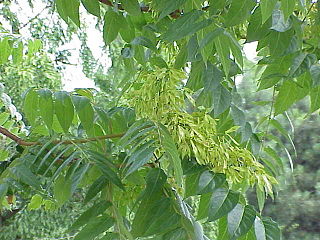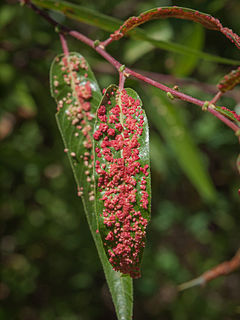
Ailanthus Brit./eɪˈlanθəs/, U.S. /eɪˈlænθəs/, is a genus of trees belonging to the family Simaroubaceae, in the order Sapindales. The genus is native from east Asia south to northern Australasia.

Biological control or biocontrol is a method of controlling pests such as insects, mites, weeds and plant diseases using other organisms. It relies on predation, parasitism, herbivory, or other natural mechanisms, but typically also involves an active human management role. It can be an important component of integrated pest management (IPM) programs.

Sarcoptes scabiei or the itch mite is a parasitic mite that burrows into skin and causes scabies. The mite is found in all parts of the world. Humans are not the only mammals that can become infected. Other mammals, such as wild and domesticated dogs and cats as well as ungulates, wild boars, bovids, wombats, koalas, and great apes are affected.

Ailanthus altissima, commonly known as tree of heaven, ailanthus, varnish tree, or in Chinese as chouchun, is a deciduous tree in the family Simaroubaceae. It is native to northeast and central China, and Taiwan. Unlike other members of the genus Ailanthus, it is found in temperate climates rather than the tropics.

The Simaroubaceae are a small, mostly tropical, family in the order Sapindales. In recent decades, it has been subject to much taxonomic debate, with several small families being split off. A molecular phylogeny of the family was published in 2007, greatly clarifying relationships within the family. Together with chemical characteristics such as the occurrence of petroselinic acid in Picrasma in contrast to other members of the family such as Ailanthus this indicates the existence of a subgroup in the family with Picrasma, Holacantha, and Castela.

Samia cynthia, the ailanthus silkmoth, is a saturniid moth, used to produce silk fabric but not as domesticated as the silkworm, Bombyx mori. The moth has very large wings of 113–125 mm (4.4–4.9 in), with a quarter-moon shaped spot on both the upper and lower wings, whitish and yellow stripes and brown background. There are eyespots on the outer forewings. The species was first described by Dru Drury in 1773.

Eriophyidae is a family of more than 200 genera of mites, which live as plant parasites, commonly causing galls or other damage to the plant tissues and hence known as gall mites. About 3,600 species have been described, but this is probably less than 10% of the actual number existing in this poorly researched family. They are microscopic mites and are yellow to pinkish white to purplish in color. The mites are worm like, and have only two pairs of legs. Their primary method of population spread is by wind. They affect a wide range of plants, and several are major pest species causing substantial economic damage to crops. Some species, however, are used as biological agents to control weeds and invasive plant species.

Fuchsia magellanica, commonly known as the hummingbird fuchsia or hardy fuchsia, is a species of flowering plant in the evening primrose family Onagraceae, native to the lower Southern Cone of southern South America.
Neoseiulus cucumeris, the cucumeris mite, is a species of predatory mite in the family Phytoseiidae. It is used in biological pest control of western flower thrips in cucumber and some other greenhouse crops.

Arabis serotina is a rare species of flowering plant in the mustard family known by the common name shale barren rockcress. It is native to eastern West Virginia and western Virginia in and around the Shenandoah Valley, where it is known from fewer than 60 populations. It is endemic to the shale barrens, a type of habitat characterized by steep slopes of bare shale, an exposed, rocky habitat type that is subject to very dry and hot conditions. Shale barrens host a number of endemics, such as Allium oxyphilum and Taenidia montana, and this rockcress is among the rarest. It is a federally listed endangered species.

Eligma narcissus, the ailanthus defoliator, is a moth in the family Nolidae. The species was first described by Pieter Cramer in 1775. It is found in tropical Asia and the subtropics of China, India, Sri Lanka, Java and Southeast Islands.

Verticillium nonalfalfae is a soilborne fungus in the order Hypocreales. It causes verticillium wilt in some plant species, particularly Ailanthus altissima. The fungus produces a resting mycelium characterized by brown-pigmented hyphae. It is most closely related to V. albo-atrum and V. alfalfae.

Aculops fuchsiae, commonly known as fuchsia gall mite, is a species of mite in the family Eriophyidae. It feeds on Fuchsia plants, causing distortion of growing shoots and flowers. It is regarded as a horticultural pest.
Typhlodromips swirskii, the Swirski mite, is a species of predatory mite in the family Phytoseiidae. It is used in biological pest control of western flower thrips in greenhouse or indoor grown crops.

Aculops tetanothrix, also known as the willow gall mite, is a species of mite that belongs to the family Eriophydae. The mite is yellow, with brown or sometimes orange.

Hongchunping Temple is a Buddhist temple located on Mount Emei, in Emeishan City, Sichuan, China.

Aculops is a genus of mites that belongs to the family Eriophyidae that live as plant parasites. Some species, such as Aculops lycopersici, are severe crop or ornamental pests, while Aculops ailanthii is being considered as biocontrol for the extremely invasive tree-of-heaven in North America. Very little is known about this genus, with new species constantly being discovered even in well covered regions such as New Zealand.

Carex juniperorum, the juniper sedge, is a perennial flowering plant native to North America, first described by botanist William J. Crins in 1993. C. juniperorum is in the Cyperaceae (sedge) family, and is closely related to C. jamesii and C. willdenowii. It is commonly called juniper sedge as it is often seen growing in areas with red cedar, though the presence of cedar is not necessarily a requirement for it to grow.
Eucryptorrhynchus brandti, the snout weevil, is an insect in the weevil family. In its native range in China, it causes significant damage to its single host, Ailanthus altissima, tree of heaven. Thus the weevil is under study as a biological control of tree of heaven in regions where the tree is non-native. In particular, the insect acts as a vector for Verticillium nonalfalfae, a soilborne fungus that causes verticillium wilt.














